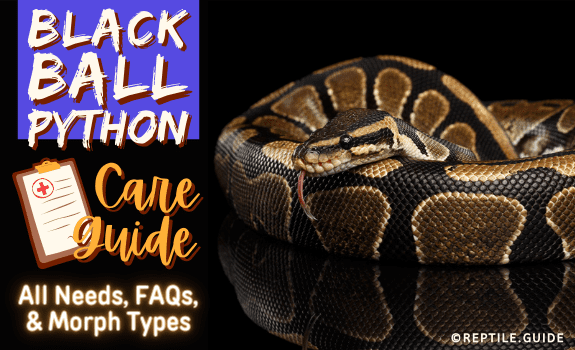The black ball python is one of many morphs of these fascinating snakes.
Different morphs are not all equally common, but they do require similar care.
In this article we’ll discuss:
- Where to buy black ball pythons
- How much black ball pythons cost
- The different black ball python morphs
- How to care for and sustain a healthy animal
In This Article
Black Ball Python Price
A standard black ball python morph costs between $50 and $100.
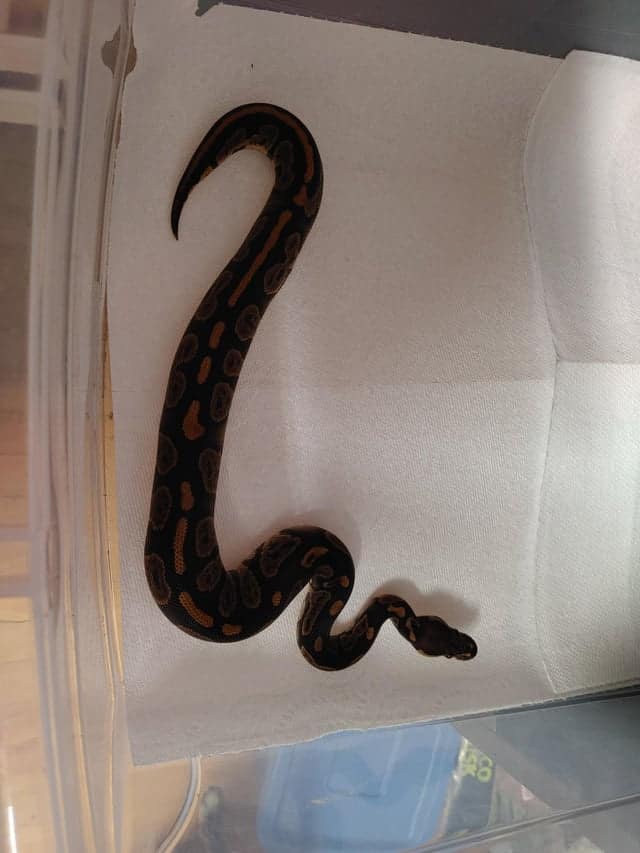
Image credit: u/smashedvermin (via Reddit.com)
However, not every black morph has the same price.
- Black pastel ball python – $200
- Black pewter ball python – $200
- Black axanthic ball python – $1,000
- Super black pastel ball python – $450
Direct descendants of a black ball python, or those who have the word black in their name include:
- Albino black pastel ball python – $400
- Black pastel banana ball python – $450
- Black-eyed leucistic ball python – $700
Fun Fact: Not too long ago, a black and white ball python (the piebald super black pastel ball python) fetched a whopping $16,000 at auction.
As you can see, prices for black morphs vary significantly!
Where to Buy Black Ball Pythons
Whether you’re looking to buy a black pastel ball python or another morph, there are many places to choose from.
Our favorite platforms for buying ball pythons allow you to communicate with the breeder directly. These include buying:
- Directly from a breeder
- At reptile conventions and expos
- Through online reptile marketplaces
We don’t recommend buying snakes from:
- Pet stores
- Grocery stores
- General listing websites
While these places might seem viable, they often can’t give you information about the snake’s background.
Additionally, many stores are ill-equipped to deal with snakes, so the animals may not get the best care.
Let’s take a closer look at our favorite places to buy your next morph.
Directly From a Breeder
Buying directly from a breeder through their website is an excellent option.
Many breeders sell directly to the public, making it easy for customers to get the reptiles they want.
The breeders will courier the animals to your door.
Before placing an order:
- Ensure that you aren’t expecting high or low temperatures.
- Check forums to ensure that the breeder has a good reputation
- Check review sites to read about other buyers’ experiences with the breeder
Pro Tip: Reptiles may suffer fatalities when undergoing shipping during blizzards or heat waves. It’s best to wait for mellower temperatures before buying.
When buying this way, the breeder often offers you invaluable history and veterinary experience that they also practise in the care of their animals.
Online Reptile Marketplaces
Online reptile marketplaces, like MorphMarket, are an ideal option if you want all the available morphs gathered in one place.
The website reviews every breeder that signs up to ensure that they’re offering a quality service. They also offer legal protection for buyers.
As with most online stores, the greatest advantage is the convenience of buying what you want without ever leaving your home!
You can often talk to the breeder directly, and learn about how they’ve been keeping their reptiles.
As with buying directly from a breeder, the snake gets shipped to your door.
Reptile Conventions and Expos
If you prefer the personal touch, then reptile conventions (or Repticon for short) are the ideal option.
Smaller reptile expos are also an excellent choice. The organizers of these events host breeders from around the country.
They run checks on all the applicants, so you can rest assured that you’ll be buying from an experienced breeder.
Unlike the other options on the list, you get to see the snake in person and can take it home with you.
Black Ball Python Appearance
The only real qualifying characteristic for a black ball python is that it’s mainly black.
For example, the black pastel ball python has larger black patches than other ball python morphs.
The black pastel ball python is probably the most common black morph. The axanthic ball python is black and white or black and gray.
Super black pastel ball pythons have even more intense coloration than the other two.
In every way, apart from coloration, a black morph looks like any other ball python. They have the typically robust head and bulky body of other ball pythons.
How Big Do Black Ball Pythons Get?
All ball python morphs reach lengths of five to six feet.
Whether it’s a super black pastel ball python or a black pastel ball python, it will reach the same size.
Male ball pythons are slightly smaller than females, reaching only five feet. Females may reach lengths of six feet.
Caring For Black Ball Pythons
The care for all ball pythons is the same, including morphs like the super black pastel.
The following sections will take a look at the essentials, namely:
- Heating and lighting
- Feeding ball pythons
- Enclosure size and setup
- Substrate and cage decor options
Since the black pastel morph is one of the most common, we’ll assume we’re caring for a black pastel or super black pastel.
Enclosure Size
Your super black pastel will need three cages in the course of its life. You’ll need to upsize the enclosure once a year for the first three years.
- Young hatchling ball pythons can easily live in a 10-gallon enclosure (year 1)
- Juveniles will need a 20-gallon enclosure
- Adult pythons will need at least a 30-gallon enclosure, though 40 might be better.
Check out our ball python enclosure guide for more excellent information about setting up your snake’s new home.
Substrate
The substrate will serve several important roles in your super black pastel enclosure.
It will:
- Give the snake a sense of security
- Help to maintain humidity levels
- Make the enclosure easier to clean
We suggest using one of the following substrates:
Each of them has pros and cons, but all of them work well.
If you want to learn more about how each of them works, check out our article about ball python substrates.
However, some substrates pose a health or safety risk, and you should never use them. They include:
- Sand
- Gravel
- Pine shavings
- Artificial outdoor carpet
Heating and Humidity
Snakes and other reptiles are cold-blooded animals who can’t control their body temperature internally.
You’ll need to give your black pastel snake a temperature gradient to keep it healthy.
This is easy to accomplish by heating only one side of the enclosure. That way, one side will be far cooler than the other.
Of course, if you live in a cold location, you may have to warm both sides, but to different temperatures.
We suggest using the following temperatures:
- Cool end – 76-80°F
- Warm end – 88-92°F
- Ambient temperature – 81-83°F
- Night-time temperature – 70-75°F
The best way to heat the enclosure is using a basking light or ceramic heat emitter. They simulate the natural basking activity of wild snakes.
If you want to keep your black pastel python healthy, you also need to monitor the humidity levels.
Fortunately, ball pythons have lower humidity needs than some other tropical species. Aim for a relative humidity of between 50% and 60%.
It’s easy to maintain this humidity level by using a large water dish and misting the substrate every couple of days.
We suggest placing a thermometer/hygrometer combo on each side of the enclosure.
They’ll help you to monitor the temperature and humidity throughout the enclosure.
Lighting
Your snake won’t require a lot of lighting. Like other morphs, the black pastel needs a day and night cycle.
Essentially, that means that the light should be on for 12 hours and off for 12 hours. This mimics day and night and helps keep the snake healthy.
Wild snakes naturally adjust their activity according to daylight, and your snake won’t stay healthy if it can’t do the same.
If you’re already using basking lights, you don’t need to use additional lighting.
If you’re not, you’ll need to add a light source.
Though the snake doesn’t need UVB to survive, we recommend using UVB bulbs. This type of light enhances coloration and boosts immunity.
You can buy a timer to help switch the lights on and off every day.
If you intend to breed your pythons, a scheduled light cycle helps induce mating activity.
Security and Setup
Beyond a good substrate and the right conditions, your python needs three things to feel secure:
- Hides
- A water dish
- Things to climb on
Hides help the snake to feel secure and give it a place to rest. We’d suggest using three:
- A humid hide
- One on the enclosure’s cool end
- One on the enclosure’s warm end
This setup will allow your pet to moderate its temperature while resting.
The humid hide is full of a moist substrate and has a higher humidity for when your snake needs to shed.
A water dish gives your snake a place to soak and drink water. It also helps maintain the enclosure’s humidity levels.
Finally, whilst these snakes are terrestrial, they also like climbing. Providing branches and other objects for them to climb on will make them feel secure.
Diet
The black pastel and other black morphs eat the same diet as any other ball python.
In the wild, these animals live near water sources where they feed on reptiles, amphibians, birds, and small mammals.
In captivity, your ball python will feed mostly on small rodents. They can also eat chicks, feeder lizards, and other small animals.
The rule of thumb is to never feed your snake anything larger than the thickest part of its body.
Ball pythons that are less than one year old need to eat every week. Older animals need a meal every 10-14 days.
If you’re looking for a reliable ball python food and supplies online store, we recommend Chewy! It is the most trusted and convenient online destination for reptile pet owners.
Click here to save 30% on your first order. We may receive a small commission if you purchase after clicking.
This DOESN’T change what you pay or what we recommend. It does help fund the research we put into the site, and we’re grateful for any support!
Black Ball Python Morphs
While there aren’t as many black ball python morphs as there are pattern types, there are several types where black is dominant.
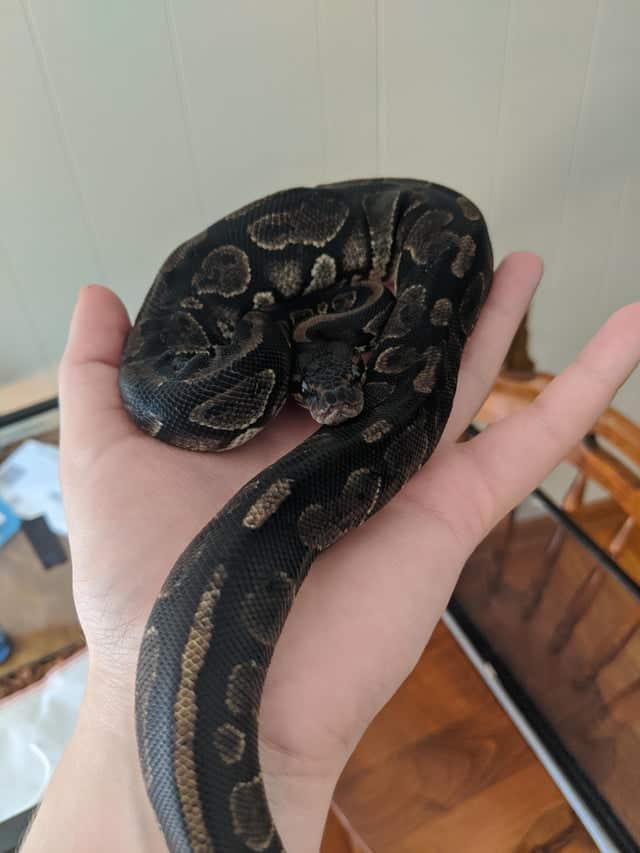
Image credit: u/White-Trash-Zombie (via Reddit.com)
The following sections take a closer look at what black morphs are, and investigate some of the more popular morphs.
What Are Black Ball Python Morphs?
Black ball python morphs are specific color variations of the standard ball python, Python regius.
Breeders create each new morph by intentionally breeding snakes with unusual or new colors or patterns.
By using line breeding and other techniques, one snake with a unique appearance can become the start of a new morph.
Essentially, a snake of any morph has the genetic code for a specific appearance.
That genetic code gets passed down to its offspring, allowing breeders to reliably create snakes with a similar appearance.
Super Black Pastel Ball Pythons
The super black pastel ball python has the gene that gives the black pastel its distinct appearance twice.
As a result, it’s twice as dark as a normal black pastel ball python, with exaggerated patterns.
When you breed these animals, you have a guarantee that they’ll pass the black pastel gene down to their offspring.
This means that the super black pastel ball python is essential in creating new morphs.
Albino Black Pastel Ball Python
The albino black pastel ball python is a beautiful morph that’s a cross between the black pastel ball python and the albino ball python.
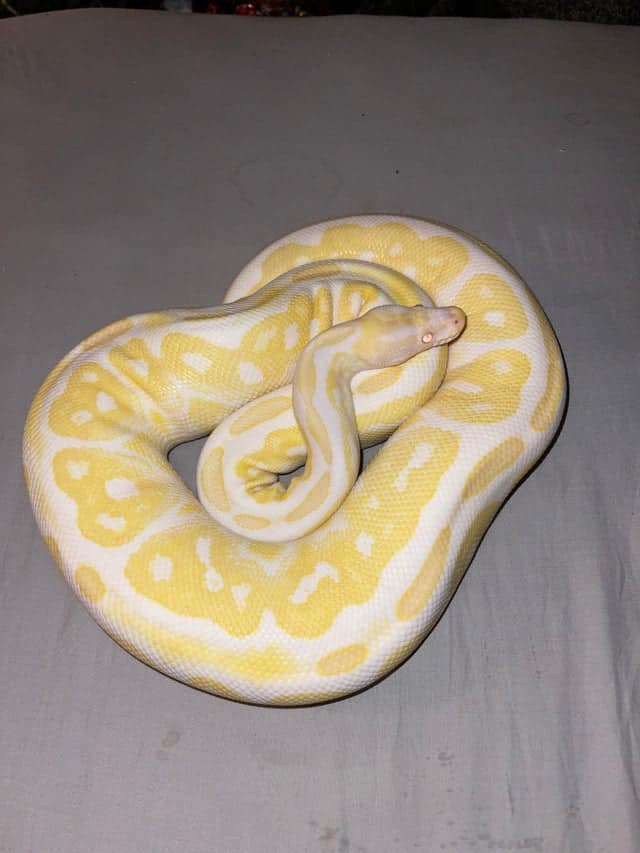
Image credit: u/Senior_Ad_5501
The albino gene means that these animals have no black coloration. Instead, they’re white and yellow.
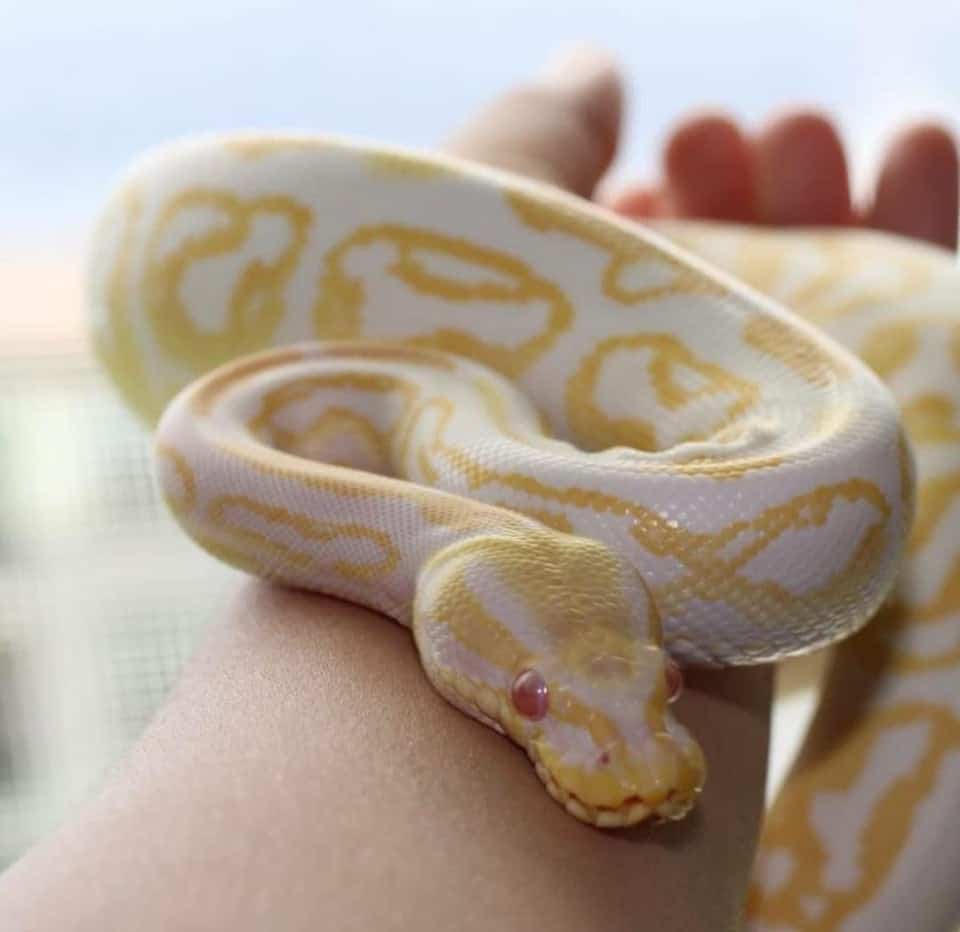
Image credit: u/wingsofbahamut (via Reddit.com)
Their patterns look like that of the black pastel, but the colors are different. This is likely one of the morphs that descended from the super black pastel.
Black Pewter Ball Python
The black pewter is a cross between the black pastel and a jungle pastel. They have beautiful silver and black coloration.
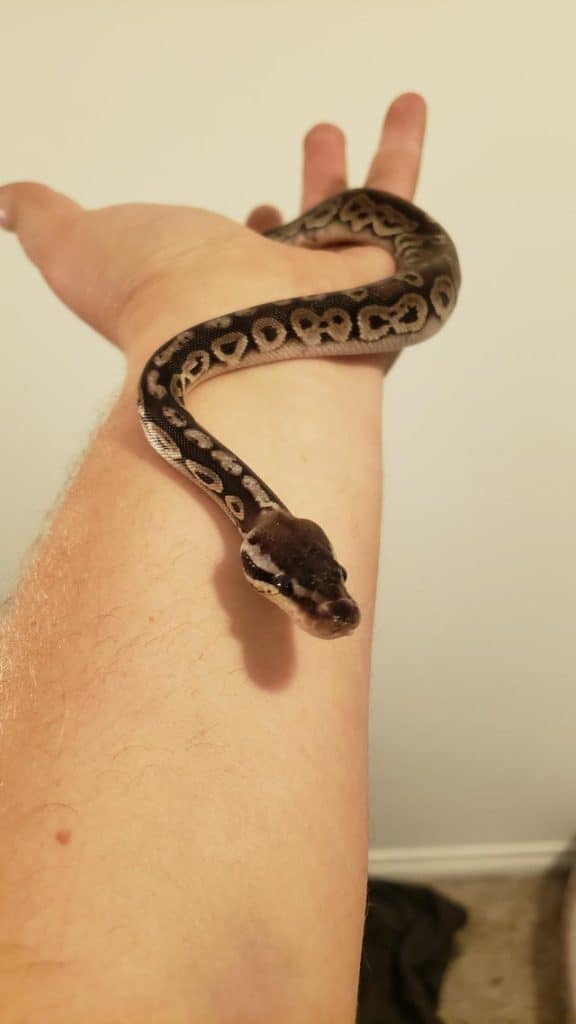
Image credit: u/Blackheartrwby (via Reddit.com)
These snakes get their name from an inexpensive alloy of metals that had a silvery sheen.
Black Axanthic Ball Python
The black axanthic morph doesn’t produce red and green pigments. The result is a gorgeous black and gray snake without red or brown markings.
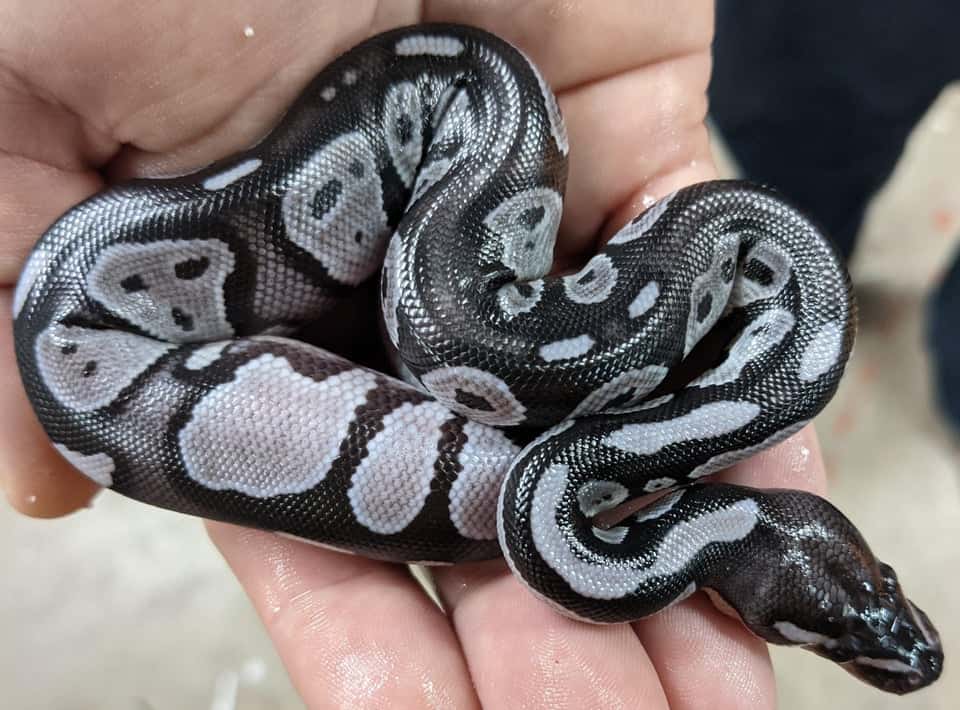
Image credit: u/Chaos_Incarnate43 (via Reddit.com)
Despite what you might think, this line was produced independently from morphs like super black pastel.
The pre-existing axanthic lines don’t feature in their genetics.
Black Eyed Lucy Ball Python
The black-eyed lucy ball python or black-eyed leucistic, doesn’t produce all the color pigments possible in the eye.
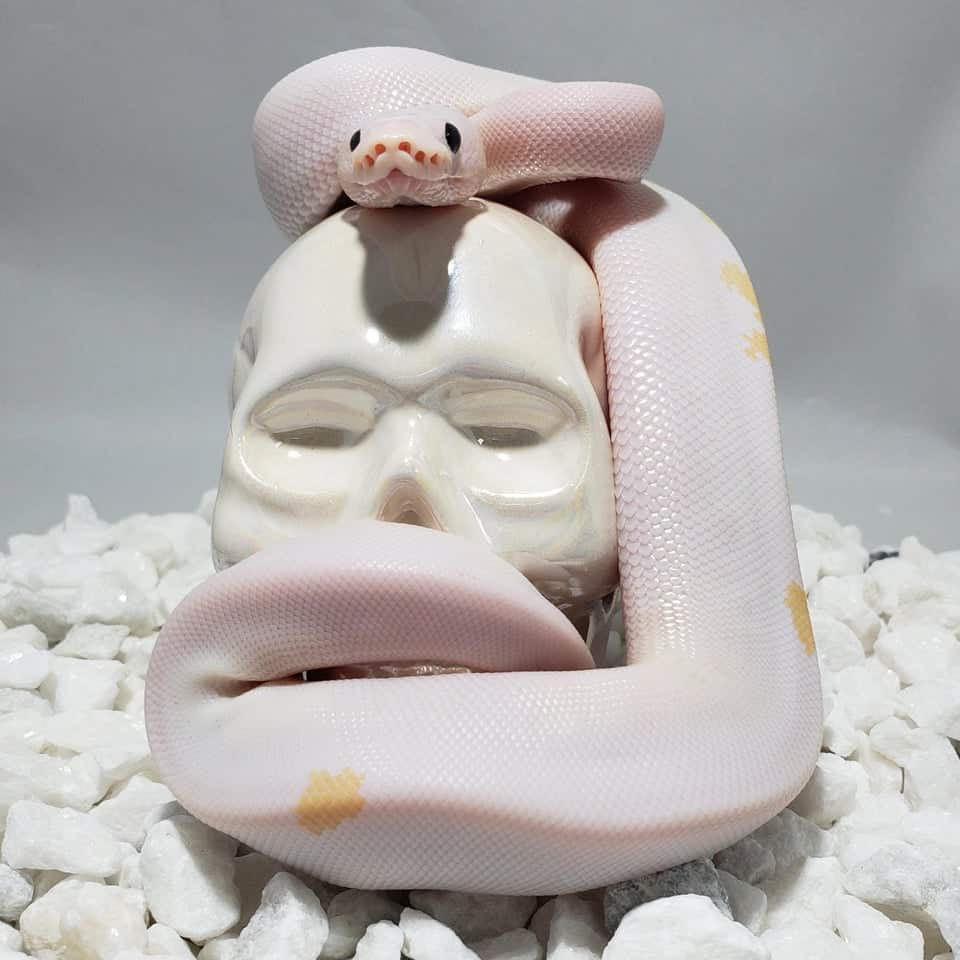
Image credit: u/Nomskitty (via Reddit.com)
This means that its eyes are pitch black. The contrast between the black eyes and peach-colored body is truly striking!
We hope you’ve enjoyed this article about the black super pastel and other black morphs.
Don’t forget to check out our 39 ball python facts to learn more about these fascinating animals.
